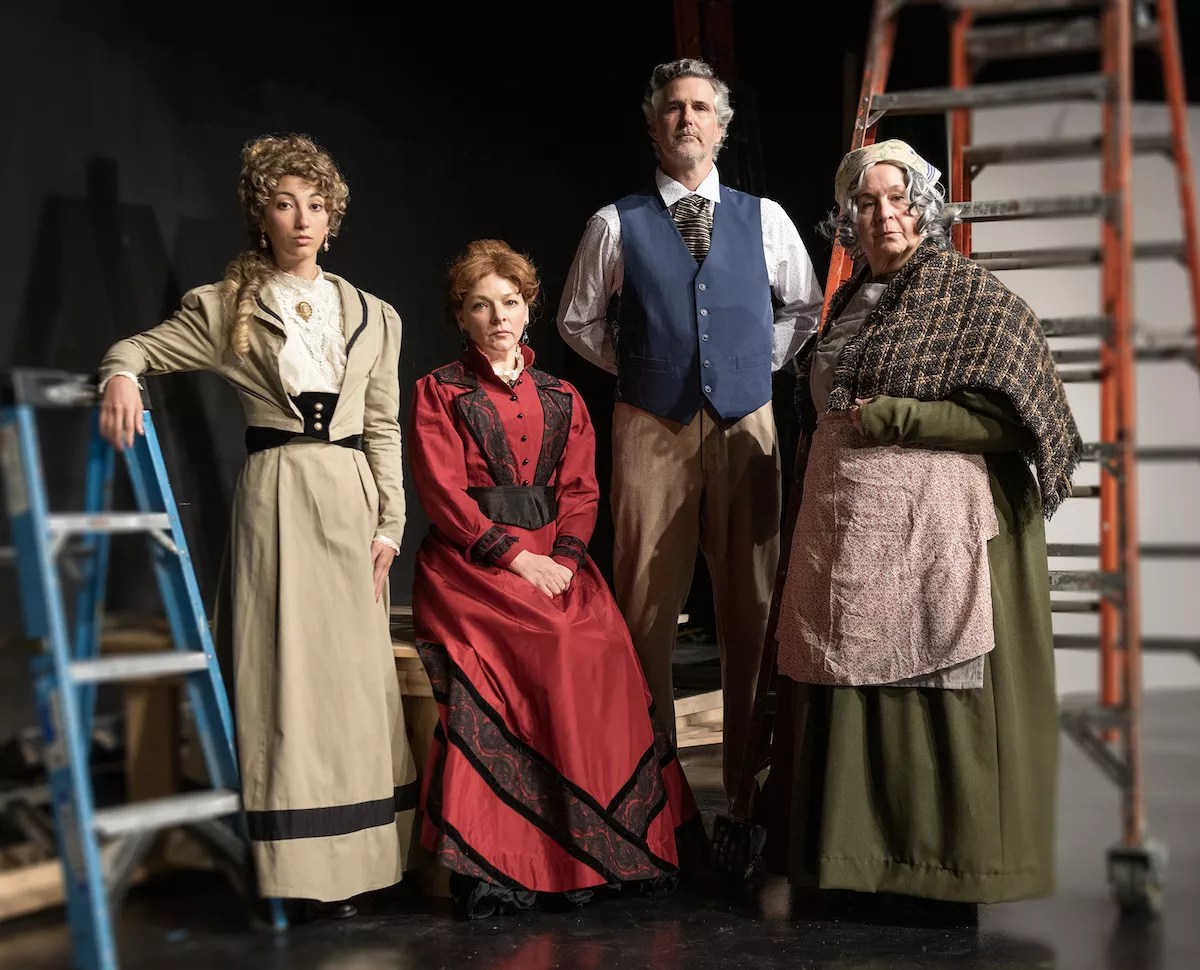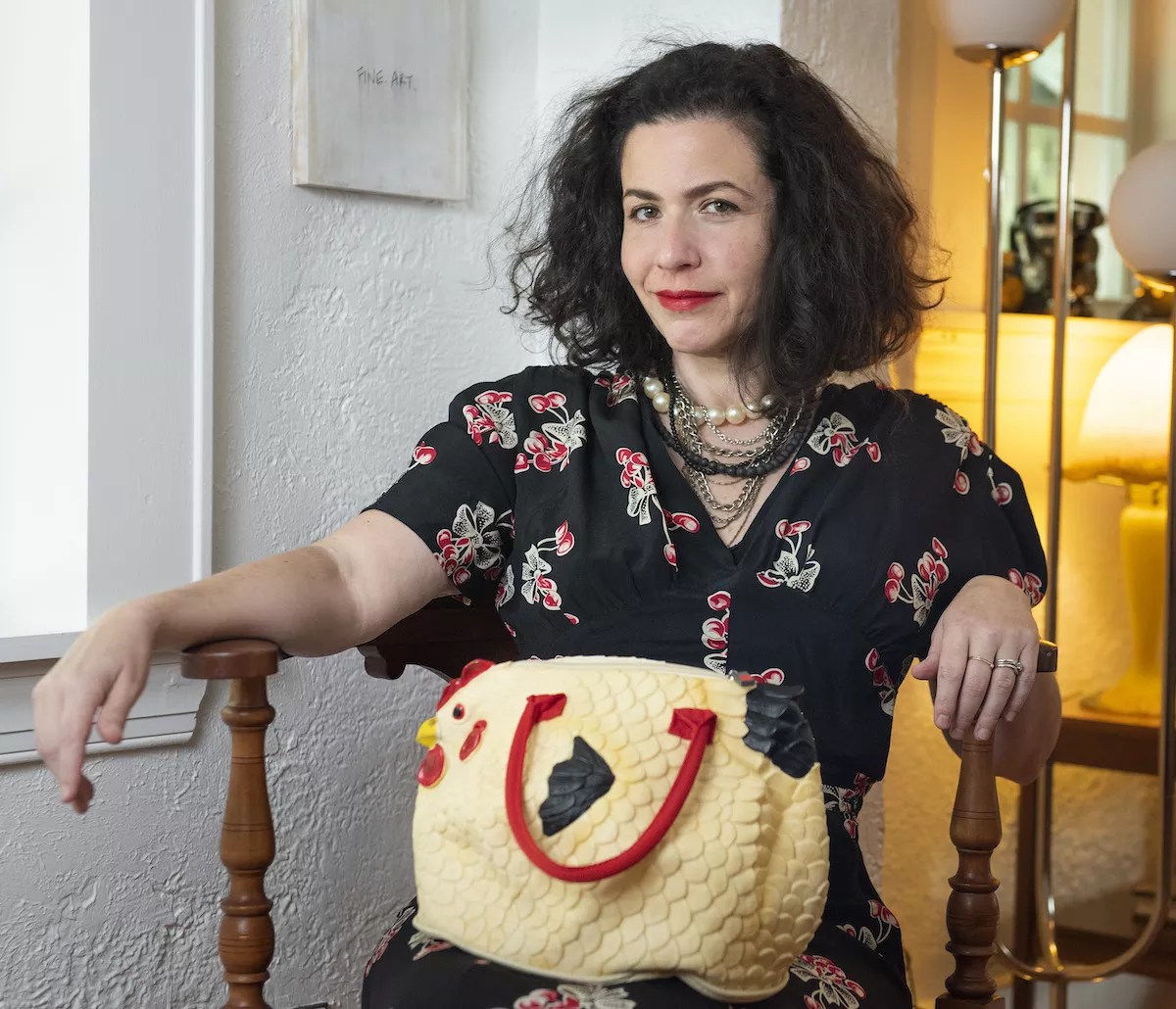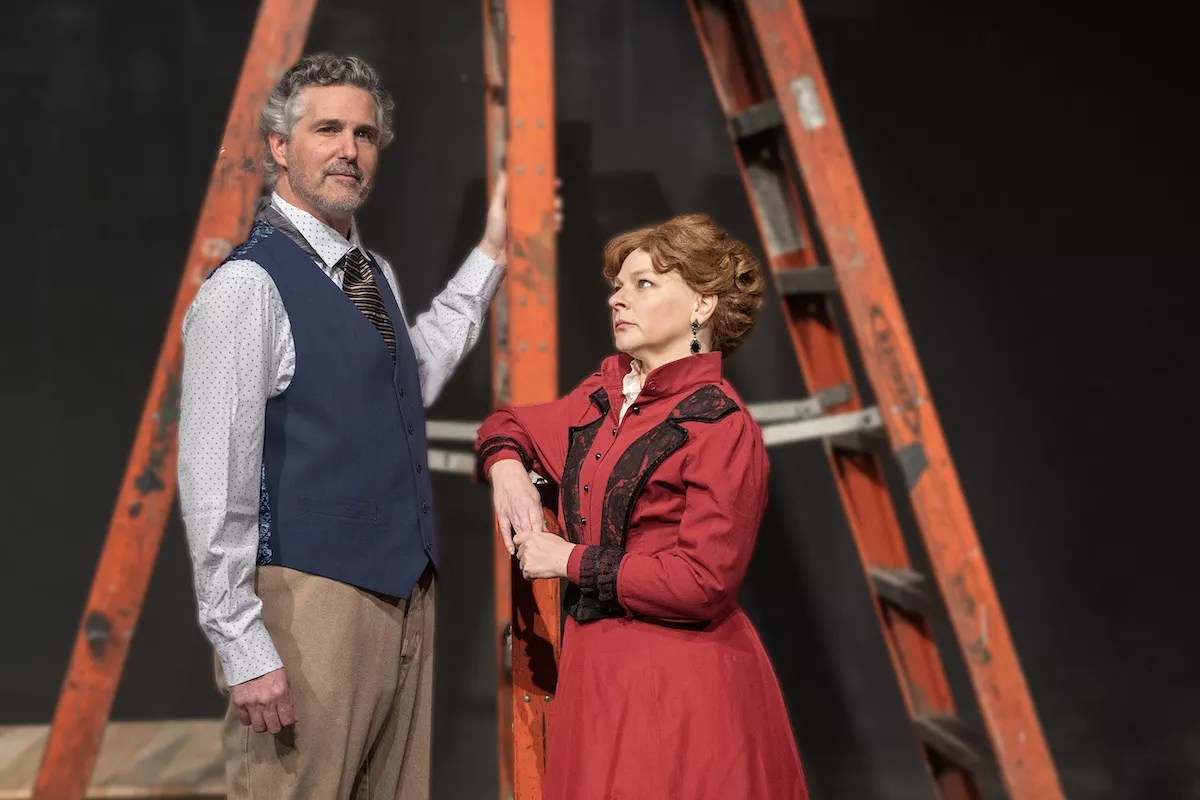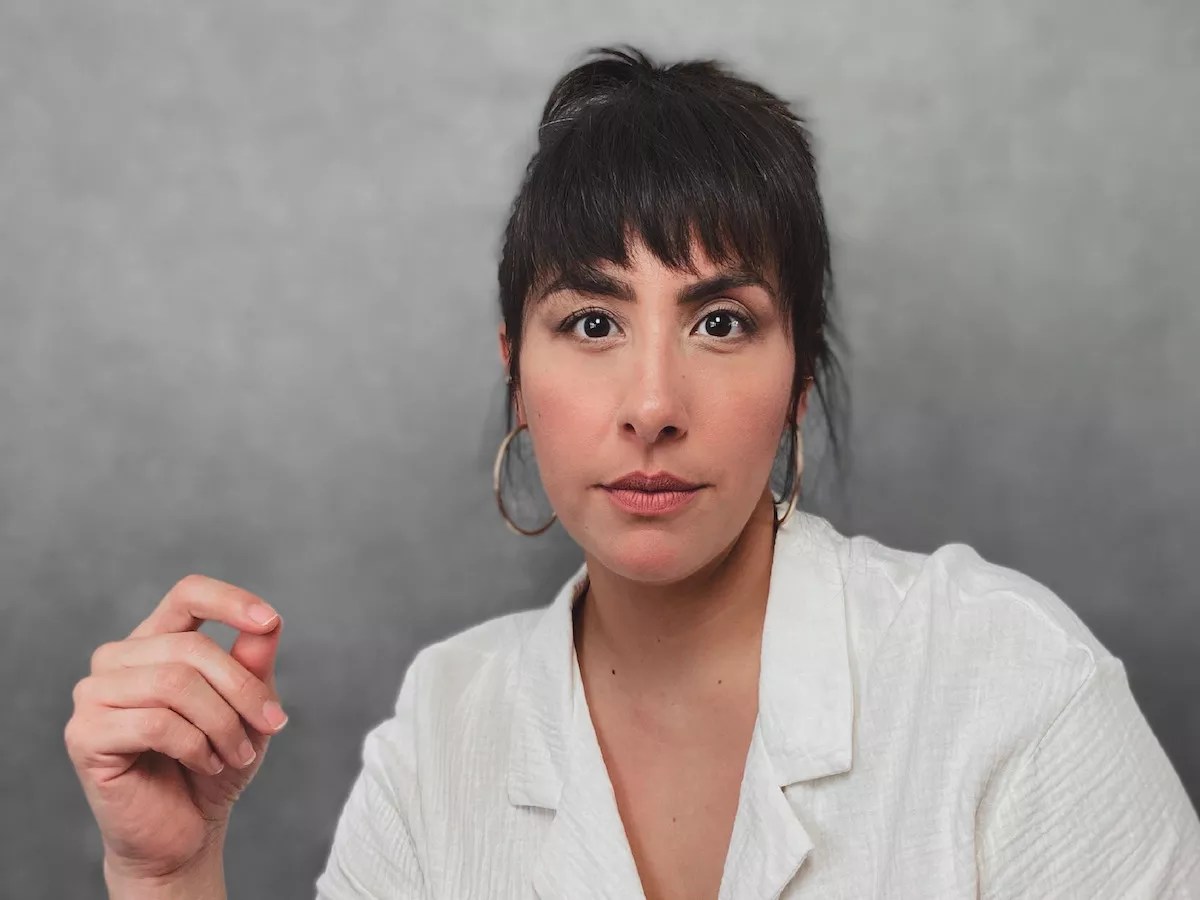
Photo by Magnus Stark

Audio By Carbonatix
The slamming door that brings Henrik Ibsen’s A Doll’s House to its shocking close has been reverberating on stages since 1879 when the masterpiece about a Norwegian wife and mother who dared to defy societal conventions ushered modernism into theater.
Fast forward to 2017, when one of America’s “it” playwrights, Orlando-native Lucas Hnath, imagined what might happen if an incommunicado Nora Helmer came back 15 years later, knocking on that very same door.
A Doll’s House, Part 2, which will get its first Miami-area production at GableStage from February 24 through March 19, isn’t precisely a sequel to the classic that inspired it. Rather, it’s a four-character, 90-minute exploration of one way the story might have played out.
One of the most-produced plays in American regional theaters (the Maltz Jupiter Theatre did it in 2019), A Doll’s House, Part 2 marked the Broadway debut of the topically and stylistically eclectic Hnath, whose subjects have included the ethical shortcuts of a would-be Olympian and the horrific kidnapping of Hnath’s mother.
We’re thankful for you. Are you thankful for us?
We feel thankful for our staff and for the privilege of fulfilling our mission to be an unparalleled source of information and insight in Miami. We’re aiming to raise $30,000 by December 31, so we can continue covering what matters most to this community.
Help us continue giving back to Miami.
Among his works are A Public Reading of an Unproduced Screenplay About the Death of Walt Disney (done at Fort Lauderdale’s Thinking Cap Theatre in 2016), the Obie Award-winning Red Speedo (presented by Plays of Wilton in Wilton Manors in late 2022), The Christians (staged by Outré Theatre Company in Pompano Beach in 2018), Hillary and Clinton, Dana H, and The Thin Place.
Though Hnath wasn’t available for an interview before the new GableStage production, in a 2017 Vogue story, he told writer Adam Green that when he asked participants in a workshop what they thought happened to Nora, “almost everybody said that she went off to work in a factory or became a prostitute and died.”
Hnath’s play resoundingly turns that expectation on its head.

GableStage artistic director Bari Newport
Photo by Magnus Stark
GableStage producing artistic director Bari Newport is staging the new production and says of Hnath, “I really love Lucas’ writing. He has such a sense of humor. It’s wry and smart.”
What audiences should anticipate about A Doll’s House, Part 2, she notes, is that “it’s not only a comedy, it’s not only a drama, it’s not only based on a classic. It lives within so many styles… It’s a humanist play, not just a feminist story about the price of individual freedom.”
Married actors Rachel Burttram and Brendan Powers will play the long-parted Nora and Torvald Helmer, with Carbonell Award-winner Elizabeth Dimon as housekeeper/former nanny Anne Marie. Recent New World School of the Arts grad Yasmine Harrell makes her professional debut as the Helmers’ engaged daughter Emmy.
Burttram and Powers, longtime company members at Florida Repertory Theatre in Fort Myers, were to have done the play there in March 2020. But when the COVID-19 pandemic hit and the world was about to shut down, Florida Repertory made a video of the final dress rehearsal and streamed it, earning a glowing review from the late Wall Street Journal critic Terry Teachout, who was known for championing high-quality work done in the country’s best regional theaters.
“This modernization is delicious and fabulous. It was such a heartbreak not to share it with a live audience,” Burttram says. “Three years later, you approach the text differently because of what we went through.”
Adds Powers, “We’re all changed in ways you aren’t really able to articulate. In our scenes, there are different nuances, things that hit in a more poignant way or that you remember differently.”
Burttram was an apprentice at Actors Theatre of Louisville and Newport associate director at Florida Repertory when they met 21 years ago, and Newport has directed the actors – whom she calls her “dearest friends” – either solo or as a couple in many productions since.

Real-life spouses Brendan Powers and Rachel Burttram play Torvald and Nora Helmer in A Doll’s House, Part 2.
Photo by Magnus Stark
Powers and Burttram, now based in Birmingham, Alabama, consider themselves fortunate to be able to work on the same production as often as they do. They have squared off as the warring priest and nun in John Patrick Shanley’s Doubt and have appeared together in numerous other productions, most recently in the world premiere of Mark St. Germain’s Public Speaking 101 at Great Barrington Public Theater in Massachusetts and God of Carnage at North Carolina’s Flat Rock Playhouse.
During the run of A Doll’s House, Part 2, the couple will make another joint appearance when GableStage presents a reading of Ibsen’s original at 2 p.m. on March 11. (Tickets are free, but subscribers get priority.)
“We have a shorthand, a great chemistry, and connection,” Burttram says. “We know each other so, so well, even our body language. You can dig in and play and have trust.”
Burttram describes the role of Nora Helmer as iconic. Childlike in her dependency, first as a daughter and then as a wife, Nora feels her blinders falling away when a crisis reveals the true nature of her marriage, igniting that journey toward self-awareness at the end of A Doll’s House. The Nora who returns in A Doll’s House, Part 2 is a different woman.
Powers, who played Torvald in a production of Ibsen’s play several years ago, describes Nora’s husband as “a fairly upright person in a system that’s flawed. He’s naÁ¯ve and clueless. He comes off very badly… But as the story unfolds, you discover he’s a perfectly human character. It’s fun to play someone who has two sides.”

GableStage resident dramaturg Karina Batchelor helps the company and the audience take a deep dive into A Doll’s House, Part 2.
Photo by Karla Ruiz-Gomez
GableStage’s resident dramaturg, Karina Batchelor, has played a key role in immersing the company in the worlds created by Ibsen and Hnath. The Miami native and Florida International University graduate met her husband, British actor Iain Batchelor (who was in GableStage’s The White Card), when she was earning her master’s degree at the Shakespeare Institute at Stratford-upon-Avon. Her thesis subject was on point for her current assignment: adaptations.
“I try to make sure I remove my own opinions. I provide facts [such as] what it was like to be married then, to get a divorce, and the worldwide effect of the industrialization period. I’m choosing what they get, and you have to make sure you’re not biased,” says Batchelor, whose deep-dive research also links to Victorian primary sources and topically relevant newer works.
She is, she says, very appreciative of what Hnath achieves in his dramatic postscript to A Doll’s House, which features period costumes but an otherwise minimalist look, contemporary language, and artfully conveyed information from Ibsen’s original.
“This play is amazing. Everyone is right. I very much understand Nora – I’m a mom myself – but I don’t want to be unfair to Torvald, Emmy, and Anne Marie,” Batchelor says.
“From the moment Nora walks in the door, she’s already being judged. Lucas created a play where you change your mind so often… A Doll’s House ends with Nora choosing herself, and at the end of the day, there are consequences. Nora has the bravery to come to terms with that.”
Another aspect of Batchelor’s work is audience education. She and Newport will share in doing the company’s popular preshow talks before each performance of A Doll’s House, Part 2, and one of Batchelor’s will be filmed and made available to anyone who chooses to watch the streaming version of the play. (Some subscribers are taking an even deeper plunge via a pilot program dubbed “Diary of a Production,” which offers six classes on various aspects of the play, attendance at a technical rehearsal, and a group outing to a performance.)
Anyone thinking about seeing A Doll’s House, Part 2 may wonder whether not knowing or remembering the details of Ibsen’s play will affect their enjoyment of Hnath’s carefully crafted follow-up. Powers notes that “all the important bones of the story are relayed in Part 2.”
Newport and Batchelor agree, with an asterisk.
Knowing A Doll’s House can enrich the experience of seeing A Doll’s House, Part 2, but Batchelor calls the latter “very different. I look at it like a boxing match. Each character has [their] own perspective. It feels very much like an argument, with everyone putting forth [their] case.”
“Lucas mitigates his play so it’s not an enigma for those who don’t remember A Doll’s House. It’s very accessible,” Newport says. “With all our preshow talks, we give a broader, deeper lens into the work. The more you know, the more you can appreciate.”
– Christine Dolen, ArtburstMiami.com
A Doll’s House, Part 2. Saturday, February 24, through Sunday, March 19, at GableStage, 1200 Anastasia Ave., Coral Gables; 305-445-1119; gablestage.org. Tickets cost $45 to $75. Performances take place at 2 and 7 p.m. Wednesday, 8 p.m. Thursday through Saturday, and 2 p.m. Sunday.